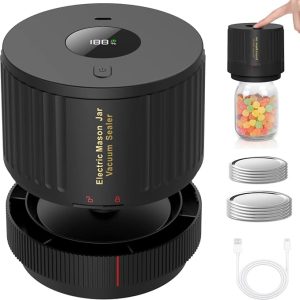 If you haven’t already discovered using a FoodSaver to preserve dry goods perfectly over long periods of time, you’re missing out. However, there are those who embrace this fantastic method of preserving dry goods or who WANT to do so, but still have a lot of questions that I didn’t cover in my articles or YouTube video. So here goes all of my troubleshooting tips and tricks for using the FoodSaver for dry goods preservation.
If you haven’t already discovered using a FoodSaver to preserve dry goods perfectly over long periods of time, you’re missing out. However, there are those who embrace this fantastic method of preserving dry goods or who WANT to do so, but still have a lot of questions that I didn’t cover in my articles or YouTube video. So here goes all of my troubleshooting tips and tricks for using the FoodSaver for dry goods preservation.
Sept. 2024 Update: There is also now a Mason Jar oxygen extractor that is awesome and much less cumbersome than the FoodSaver. I highly recommend it!
First—The FoodSaver: I’m frequently asked which model of a FoodSaver to purchase. FoodSavers have been around for quite a while now so there are plenty of models. What you need to look for though is an the air tube. You have to go back pretty far to find a model of FoodSaver that doesn’t at least come with the port to attach the air tube, in which can you can just purchase the tubing with the head that comes with it. Whatever you do, do NOT purchase the really inexpensive handheld FoodSaver version. During the course of an interview with the manufacturer, they made it clear that the handheld version is not intended to seal jars long-term. It’s very temporary in its sealing effects.
Second—Where to Buy a FoodSaver: I’m frequently seeing great sales on even the newest model of FoodSaver. Confession, I have the newest and shiniest one and I’m in love with it’s lazy features and fancy lights which don’t even require me to push a button when I’m sealing the bags. But it works just as well as my units that I got years ago. If you love functional technology and have the money, get the newest version; but if you’re like most and need to be frugal, check out the sources for used models. Amazon, E-bay, Craig’s list, Freecycle.org, and your local classifieds and thrift stores will be great resources. A lot of folks buy them thinking that they’ll save so much money on their freezer goods, but then get too lazy to take the time to actually put the products into the bags or they feel that the bags are too expensive or they discover that the bags aren’t all they are cracked up to be. As such, you can benefit from these underappreciated models. I’ve paid as little as $30 for them and as much as $129 for my newest one. I’d suggest the FoodSaver site, Costco, or Amazon or local stores like Target and Wal-mart when purchasing the new ones. You might be interested to know that Costco requires that all vendors give Costco the best pricing on their goods so that’s some peace of mind for you if you don’t want to go hunting everywhere.
Second—The Accessories:There are two sizes of openings for all canning jars—regular mouth and wide mouth. In order to preserve goods in jars, you’ll need to get a FoodSaver that has an air tube feature and you’ll need to purchase the “mason jar attachments” in the size of your choosing. (I have both since I use both sizes). Some folks are having a hard time locating the regular sized mouth attachment, but I’ve had no problem finding them at kitchen goods stores, Amazon, or the FoodSaver website. You’ll find them at $8 to $10 each (the wide mouth size costing a bit more than the regular mouth size).
Third: The Jars and Lids: Using the FoodSaver to preserve dry goods has its perks. For one, you can use USED canning lids to seal the dry goods in. So when you open a box of newly purchased jars, be sure to take the lids off so that you can keep those for pressure canning uses and instead use some of your used lids for your dry goods preservation. I wouldn’t use the spaghetti sauce jars for pressure canning, but you don’t have to worry so much when you’re using non-commercial canning jars to preserve the dry goods. So long as the jar fits the mouth size perfectly, you’ll be fine recycling those glass jars that you get other products in.
Fourth—Tips for Successful Sealing: First place the flat lid on the jar, then the attachement, and then the head of the air tube. Turn on the FoodSaver and once it’s done sealing REMOVE THE HEAD OF THE AIR TUBE first and THEN remove the jar attachment—otherwise you’ll run the risk of taking the jar lid off when you pull off the attachment. Next, grab the tip of the jar by the fingertips and lift it to make sure that it’s sealed properly. Once it has then go ahead and put the ring on it. I leave my filled jars out for a few days before putting them away to make sure that the seal doesn’t release.
I’ve had many persons tell me that they have a hard time getting the regular mouth lids to seal properly. That’s actually a FREQUENT complaint I hear, but guess what—there’s a solution. Place TWO flat lids on the jar, then the attachment and then the head of the tubing, seal it as above, and remove the attachments as noted above. You then should be able to remove the top flat lid while the bottom one remains attached to the jar with a perfect seal.
When you’re opening the jar to use your dry goods, gently pry the flat lid off with a can opener or spoon. You don’t want to bend the lid which would render it useless for sealing. You can then reseal the jar and do so again and again as you use your products. As long as you keep your lids in good condition the seal on them will last and last and last. Be sure to store everything in COOL, DRY, and DARK conditions for maximum shelf-life and to ensure that the seal pressure doesn’t break.
There are some who don’t have the jar attachment but they do have the canisters that come with some of the FoodSaver packs. What you can do is place your jar of dried goods in the canister with the flat lid on it (obviously the jar would have to be small enough to fit in the canister); put the lid on the canister and extract the oxygen from it according to manufacturer directions. When you’re finished, the lid on the jar inside the canister will be sealed. Cool, huh?
Fifth—What Can I Store This Way: You can store any dry good item so long as it’s not a fine powder as the powder will escape the jar. Cereal, brown rice, nuts, grains, candy bars, medications, vitamins, cookies, chocolate chips, and even the wrapped chunks of the butter flavored Crisco work great this way. However, if you have a fine, small particle item you will need to approach things differently. I frequently preserve cake mixes using the FoodSaver method, but since the cake mix is so fine, I don’t want to gum up my tubing, so I keep the cake mix in it’s original BAG, put the bag into my ½ gallon jar, and then seal the jar. As another example, when I want to preserve panko breadcrumbs, I place 1 cup of the crumbs in individual zip-lock baggies, and then put them in the jar and then seal the jar.
I recently did an experiment so that I can show you what happens and how the air is extracted from the jars. I placed rice flour inside a jar, put the flat lid on, and extracted like I normally do, but immediately observed the fine flour going through the tubing. When I pulled off the Mason jar attachment, there was this pile of rice flour on TOP of the flat lid. You see, oxygen is so fine that it’s pulled underneath the flat lid until there’s nothing else to extract, at which time enough pressure is built up to affix the lid to the jar. You can tell by the rice flour how the FoodSaver works on jars. IF you ever have this happen on you accidentally, immediately stop the machine and pull off the tubing head. Tap the tubing with the head pointed downwards and this will get out most of the particles. You’ll need to blow air through the small hole in the Mason jar attachment to get the particles cleared from that and you’ll want to make sure that you clean the attachment and thoroughly dry it before using it again.
Fifth—Jar Sizes: There’s really no size that’s better but I do prefer the half-gallon sized Mason jars. A lot of stores don’t carry that size readily however, nearly any store that already carries the jars is more than willing to special order them for you. I like the half-gallon size because it’s just plain easier. I can store long strips of licorice, for example, that I wouldn’t be able to fit in a wide-mouth quart jar. I can fit a whole lot of little bags of fine spices in a half-gallon jar. You should know though that half-gallon Mason jars are NOT fit for pressure canning, so please do not attempt to use them for such.
Sixth—Protecting Your Efforts: The #1 cause of jar breakage is jar to jar contact. For my quart sized jars I use the Jar Boxes, but it’s a bit more challenging to protect my half-gallon jars. So what I do is recycle the thick cardboard we get in packages and food products from Costco. I cut the cardboard down to size, while keeping it as big as possible to give me the most protection and then I slide the thick piece of the cardboard in between the contact space of the jars. I then also put packaging tape around the exterior of the box that the jars came in so as to ensure that the box doesn’t split as a result of the minor amount of added room that the cardboard pieces take. As a result, everything is in there nice and snug. Lastly, I store the jars on the bottom of shelves or other places where they aren’t likely to fall in the event of an earthquake or other incident which might rattle and roll my belongings.
Lastly—Strategy: I’ve shared time and time again that I’m the laziest “prepper” that you’ll ever meet and as a result I’ve learned that I’ve had to make things so accessible for myself so that I don’t have an excuse NOT to do it and thus get behind on what needs to be done to preserve my investments. So I have placed my FoodSavers in strategic positions. One of the older ones I bought is down in my pantry right where I bring the groceries to. This way, as I unload the groceries, I’ve already got the FoodSaver set up and ready to use. I also have my new FoodSaver up in the kitchen in a cupboard stored with all of the jar attachments and bags—again so that it’s not some major project to come home with the groceries (or other items) and immediately get them preserved before I get distracted or run out of steam. It’s a strategy and I have to take into consideration my known weaknesses (procrastination, running out of energy after a shopping trip, etc.) in order to make this particular strategy pay off. So be sure that you take into consideration what your obstacles might be to making this a regular part of storing your dry goods and act accordingly. The end results are well worth it. I can’t tell you how many times I’ve grabbed something from the pantry that I’ve had for years and years that are well past their standard shelf-life only to find them just as great as the day I bought them. Items such as brown rice, oats, and almonds which are notorious for going bad quickly are now an investment which I can easily protect. I nearly do a Happy Dance each time I grab a jar of goods—the older the product is, the better the dance. *grin*
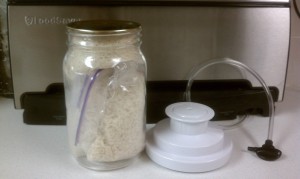

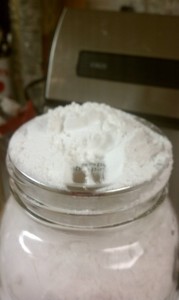
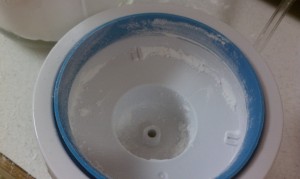
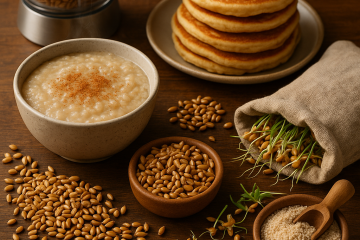

20 Comments
Karen · October 14, 2013 at 4:32 pm
Thanks for your wonderful
Thanks for your wonderful post. My husband and I have now struggled for an hour with the regular sized jar sealer attachment. We have no problems with the wide mouth attachment. Each time, the lid is pulled off at an angle and the seal is lost. I think it is a manufacturing problem. The blue ring doesn’t tuck in as well under the inside lip of the ring. We are soooooo frustrated. Love the whole concept – when it works.
Preparedness Pro · October 14, 2013 at 4:42 pm
I would contact customer
I would contact customer service regarding the regular mouth attachment. It should work like a pro just like the wide mouth one does.
Hernandez Home · November 18, 2013 at 6:42 pm
Love your site! When you
Love your site! When you vacuum the bread crumbs do you poke small holes in the zip lock bags? Thank you.
Preparedness Pro · November 18, 2013 at 7:09 pm
Nope. I just make sure that I
Nope. I just make sure that I’ve extracted the oxygen well when I seal the ziplock, but there’s not enough left in there to compromise the shelf-life or taste.
Hernandez Home · November 23, 2013 at 12:47 am
Thank you.
Thank you.
Sandra · November 24, 2013 at 9:20 pm
How long can almond flour
How long can almond flour stay fresh using this storage method?
Preparedness Pro · November 25, 2013 at 8:12 am
Almond flour–that’s a doozey
Almond flour–that’s a doozey to keep fresh for long. You’d do much better to stock up on the almonds themselves and make flour in order to have a suitable shelf-life. I wouldn’t expect almond flour to last longer than 2 years, even with this great method. Sorry to be the bearer or less than stellar news. 🙁
Joan · May 3, 2014 at 6:57 pm
If I open shredded cheese or
If I open shredded cheese or use the vacuum bags for anything that had an original package……… I try to keep it wrapped in the original package. That way the food saver bag does not get dirty and it is easy to reuse. Sometimes I even wrap
In Saran Wrap before vacuum sealing.
Betty · June 9, 2014 at 11:58 am
Can you store things like
Can you store things like oreo cookies this way? Do you have a list of food items that can be stored this way?
admin2_340 · June 9, 2014 at 4:59 pm
Hi Betty, Yes, you can store
Hi Betty, Yes, you can store cookies in this manner. I have wriiten a number of articles on food savers that should help you. Here are two of them. http://www.preparednesspro.com/foodsaver-saves-the-day ~ http://www.preparednesspro.com/you-dont-have-to-waste-your-food-storage-money Additionally, you can simply put ‘food saver’ in the search bar and find more articles. Thank you and good luck!
Betty · June 9, 2014 at 9:28 pm
Many thanks for the
Many thanks for the information and the sites. I’ve gone there and printed those for future use and reading.
Martin · August 2, 2014 at 2:43 pm
Hi from Luxembourg
Hi from Luxembourg
Love your site it helped me a lot!
Here is my tip for you, I use cosmetic cotton rounds in my jar sealer attachements to prevent getting something in the tubing it works great.
Greetings from the old World 🙂
Nan Markley · November 13, 2014 at 3:43 am
Just bought the Food Saver
Just bought the Food Saver lid. Anxious to try. What about dried beans. Do they seal well? I need to get some things from my freezer. I freeze most of my bread/cake/noodle mixes. Any advice will be greatly appreciated.
Preparedness Pro · November 14, 2014 at 3:13 am
I’ve got several dried beans
I’ve got several dried beans sealed but only the persnickety ones cause otherwise they do just fine in my 4 gallon buckets with DE.
I FoodSaver can my mixes–what little I have of them left. I now just make my own, from scratch, but those I seal in jars too.
Deb · March 20, 2015 at 3:47 pm
Do you put O2 absorbers in
Do you put O2 absorbers in your dry goods when you vacuum seal?
Preparedness Pro · March 23, 2015 at 6:12 pm
Nope
Nope
Joe Shmoe · September 1, 2015 at 7:15 pm
I just got the large and
I just got the large and regular mouth jar sealers. It’s i good thing
that I have short hair or it all would have been pulled out.
no matter how i tried to get it to work it wouldn’t. I watched endless
you tube videos and all of them looked very straight forward. There
was even one gentleman that suggested turning the gasket around. Anyways, I finally noticed that ( made in China ) was marked on the box. I then inspected everything. One of the plastic ends on the tube was almost completely clogged with plastic from the forming of the part. Absolutely zero quality control. I drilled it out with a 7/64 ths. drill bit and now it works great!
Lori · October 16, 2015 at 10:08 am
Thanks for sharing this
Thanks for sharing this wonderful and most useful tips about vacuum sealing and foodsaver.
Deej · May 4, 2016 at 2:00 pm
Hi there! Can you take your
Hi there! Can you take your cake mixes out of their boxes and place them in a bucket with oxygen packets and save that way or is it better to put them in the jars with the food saver method? What kind of shelf life do you get from the jar vs the bucket method (if that works)??
Preparedness Pro · May 4, 2016 at 5:21 pm
I use the foodsaver/jar
I use the foodsaver/jar method instead since plastic is not impervious to oxygen.
Comments are closed.